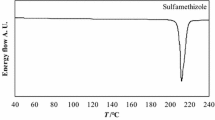Abstract
The solvent transport number, Δ, of dimethyl sulfoxide andGibbs solvation energies of silver acetate in the binary solvent systems, water—DMSO and methanol—DMSO, were determined by employingEMF and solubility measurements. While the transfer free energy of the salt increases from water to water—DMSO mixtures (up toX DMSO =0.7) and then decreases, it continuously decreases from methanol to methanol—DMSO mixtures. In both mixed solvents, ΔG° t(Ag+) decreases down to pureDMSO and that of acetate ion increases with increasing composition ofDMSO indicating that silver ion is preferentially solvated byDMSO and acetate ion by water or methanol in these mixtures. The solvent transport numbers, Δ, ofDMSO are positive throughout, passing through a maximum atX DMSO =0.45 (Δ=1.0) in the case of water—DMSO mixtures and atX DMSO =0.25 (Δ=1.8) in methanol—DMSO mixtures. This observation is shown to be in accord with the conclusions arrived at from the transfer energy data of the salt in the two mixtures.
Zusammenfassung
Es wurde die Lösungsmitteltransportzahl (Δ) von Dimethylsulfoxid und dieGibbssche Solvatationsenergie von Silberacetat in den binären Lösungsmittelsystemen Wasser—DMSO und Methanol—DMSO mittelsEMK- und Löslichkeitsmessungen ermittelt. Während die freie Energie des Transfers des Salzes beim Übergang von Wasser zu Wasser—DMSO-Mischungen zunächst ansteigt (bisX DMSO =0,7) und dann abfällt, ist für das System Methanol bzw. Methanol—DMSO ein kontinuierlicher Anstieg feststellbar. In beiden Mischsystemen fällt ΔG°t(Ag+) bis zu reinemDMSO, der entsprechende Wert für Acetat steigt bei großeren Anteilen vonDMSO an. Das zeigt, daß das Silber(I)ion bevorzugt vonDMSO solvatisiert wird, Acetat von der jeweils anderen Komponente (Wasser bzw. Methanol). Die Lösungsmitteltransportzahl Δ fürDMSO ist stets positiv mit Maxima beiX DMSO =0,45 (Δ=1,0) für Wasser—DMSO undX DMSO =0,25 (Δ=1,8) für Methanol—DMSO. Diese Beobachtung steht im Einklang mit Rückschlüssen, die aus den Transferenergiedaten des Salzes in den zwei untersuchten Systemen getroffen werden können.
Similar content being viewed by others
References
Parker A. J., Electrochim. Acta21, 671 (1976).
Schneider H., Electrochim. Acta21, 711 (1976).
Parker A. J., Diggle J. W., Auraamides J., Aust. J. Chem.27, 721 (1974).
Rodehuser L., Schneider H., Z. Phys. Chem.100, 119 (1976).
Janardhanan S., Kalidas C., Bull. Chem. Soc. Japan53, 2363 (1980).
Janardhanan S., Kalidas C., Proc. Indian Acad. Sci. (Chem. Sci.)90, 89 (1981).
Schneider H., Solute—Solvent Interaction (Coetzee J. F.,Ritchie C. D., eds.), p. 301. New York: 1976.
Maricle D. L., Hodgson W. G., Anal. Chem.37, 1562 (1965).
Wagner C., Advances in Electro Chemistry and Electrochemical Engineering4, 1–46. New York: Wiley. 1966.
Courtot-Coupez J., Le Demezet M., Laouenan A., Madee C., J. Electroanal. Chem.29, 21 (1971).
Cox B. G., Mctigue P. T., Aust. J. Chem.20, 1815 (1967).
Author information
Authors and Affiliations
Rights and permissions
About this article
Cite this article
Janardhanan, S., Kalidas, C. Preferential solvation of silver(I) acetate in water, methanol and their mixtures with dimethyl sulfoxide. Monatsh Chem 113, 691–698 (1982). https://doi.org/10.1007/BF00809007
Received:
Accepted:
Issue Date:
DOI: https://doi.org/10.1007/BF00809007




